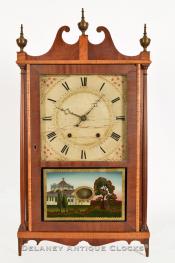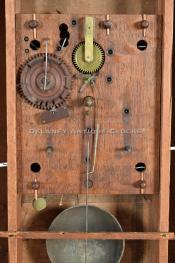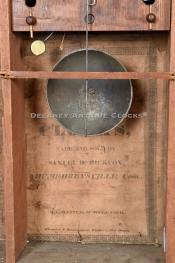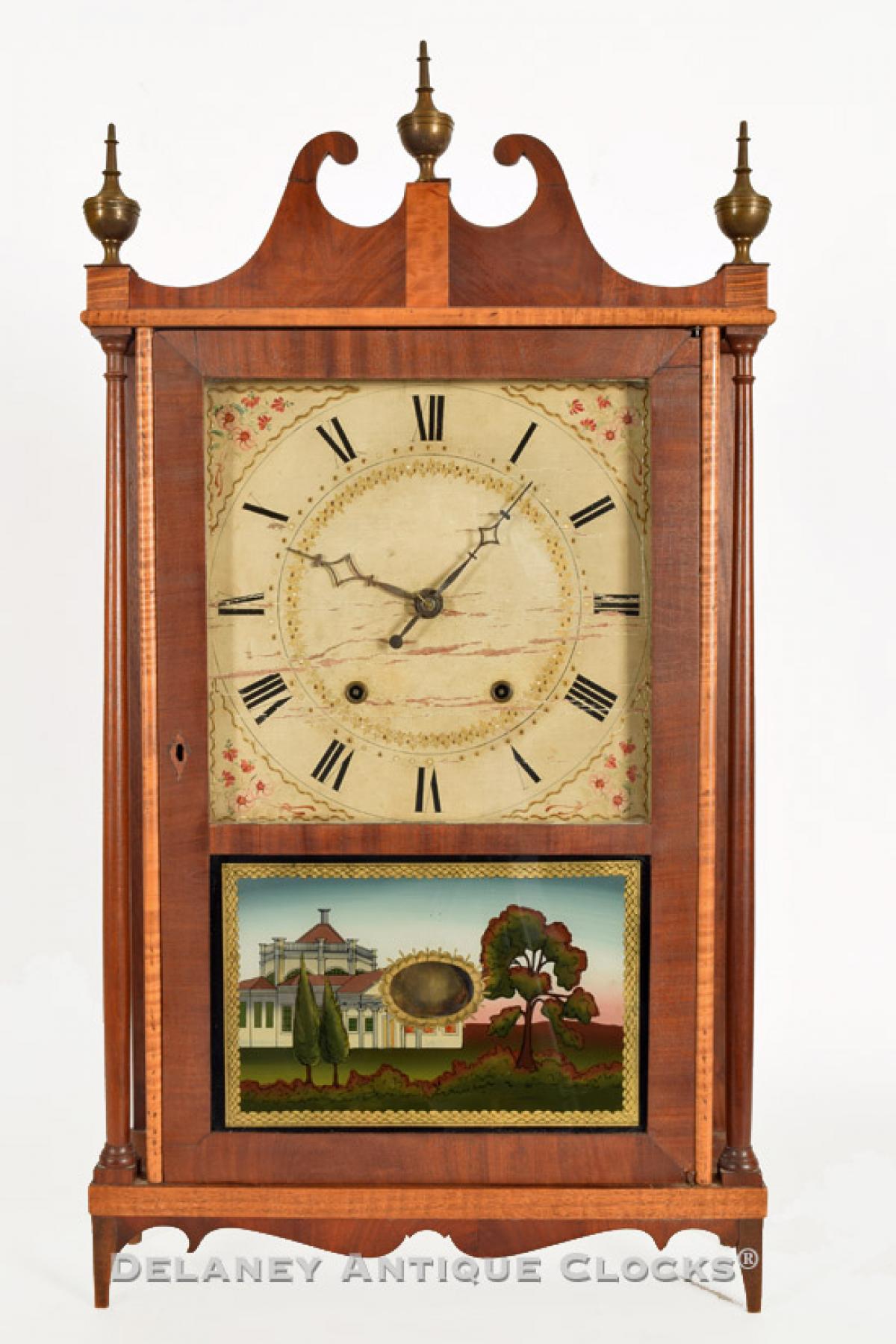Samuel Hickcox Pillar & Scroll Clock made in Humphreysville, Connecticut. A colonial mantel clock. 218123.
Examples of Samuel Hickcox’s clocks do not come to the market regularly. This is a good-looking example of an attractive model. The case is mahogany and is trimmed out with tiger-maple accents. The feet, frets, and finials are original to the clock. The reverse-painted tablet has been professionally restored. The colors are excellent. The wooden dial is original to the clock. The wooden-works 30-hour weight-driven movement is a time-and-strike design. It strikes each hour on a bell mounted inside the case. The Maker’s label is pasted onto the inside of the backboard. It is in good overall condition and reads, “CLOCKS, / MADE AND SOLD BY / Samuel Hickcox / Humphreysville, Conn. / (WARRANTED, IF WELL USED.)
This is a classic New England clock. It is designed to fit on the colonial mantle piece of the period. It measures approximately 28 inches tall, 17.5 inches wide, and 5 inches deep.
This example was made circa 1830.
Inventory number 218123.
Samuel Hickcox is listed in Clockmakers & Watchmakers of America By Name & By Place. This book was written by Sonya and Thomas Spittler, and Chris Bailey. He was at work in Humphreysville in 1833-1840. He is again listed in 1857, working in Seymour.
Humpherysville was named after David Humphery. The Town of Seymour has written a brief description of David. Most of which I have included here.
General David Humphrey became an important figure in Seymour's history from the Revolutionary War period. David Humphrey was born in Derby in 1752. During the war, he joined the Continental Army and became an aide-de-camp to General George Washington. Following the war, Humphrey and Washington remained close friends. When Washington became the U.S. President, he appointed Humphrey as the nation's first ambassador, then called a foreign minister to Spain and Portugal. While Humphrey was there, he discovered the Merino breed of sheep. The Merino sheep had dark wool when spun and gave a superior quality cloth. In 1802, Humphrey shipped the first Merino sheep to the U.S., and upon arrival at the Port of Derby, they were taken to graze on the hillsides of Chusetown.
Humphrey had always been interested in manufacturing and studied their industrial systems carefully during his visits to England and France. In 1803, he purchased a large piece of property located at the falls on the Naugatuck River near many other little mills. Here, he built one of the finest woolen mills in the country.
In 1804, the name of the area was changed from Chusetown to Humphreysville in honor of the General. The village of Humphreysville prospered and attracted other manufacturing concerns. Items such as cotton cloth, paper, furniture, and tools such as augers and bits were now produced here.
Churches moved their congregations from meeting houses into larger structures; more one-room schoolhouses were built, and, in 1849, not only did the railroad enter the village, but the Humphreysville Academy, the area's first opportunity for higher education, opened.
In 1850, Humphreysville was still a part of Derby, but people in this bustling and prosperous village needed to establish their community. Leman Chatfield, who unofficially spoke for the people of the village, and several other Humphreysville residents journeyed to Hartford to petition for separation. Although it is unclear why, the people's petition requested that the town be named "Richmond." A bill was written carrying that name. However, it was said that if the town's name were changed from Richmond to something honoring the Governor of Connecticut, the bill would meet immediate acceptance. Consequently, the people honored Governor Thomas H. Seymour, and the petition changed the town's name. Seymour officially became incorporated as a town in Connecticut during the May 1850 session of the General Assembly.






